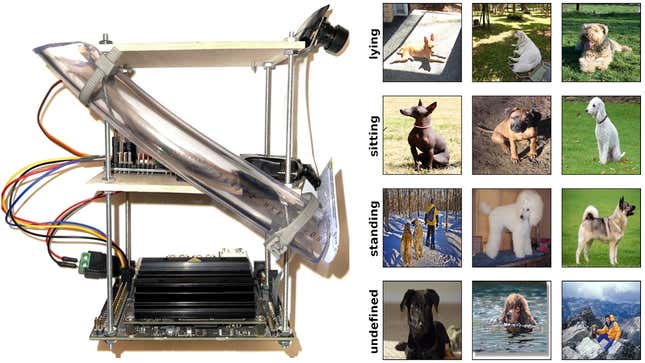
Training a dog isn’t a complicated process, it just requires repetition and positive feedback. But it’s a time-consuming process that can sometimes frustrate pet owners. There are no shortcuts, but researchers from Colorado State University have created an AI-powered device that can recognize when a dog obeys a command and rewards it with a treat.
There are good reasons to be concerned about the rapid development and improvements made to artificial intelligences created through machine learning processes, like the advent of deepfakes that are getting harder and harder to spot as being fake. But the technology isn’t all doom and gloom. It’s also being used to automate time-consuming processes like programming video game characters to behave more like real people, making robots better at navigating a house, and even upgrading the quality of old footage so it looks spectacular on 4K TVs.
Anyone who’s recently gone through the process of training a new puppy (sacrificing countless slippers along the way) knows that perseverance is key, but keeping up a routine and a regular reward system isn’t easy when you’re constantly distracted by surprises left on the rug. Automatic treat dispensers already exist, but at most, the only criteria they require for a reward is for a dog to press a button with their snout or paw. So Jason Stock and Tom Cavey, two computer science graduate students at Colorado State University, invented a smarter treat dispenser built around Nvidia’s Jetson Nano AI platform.
With a plastic tube full of treats that are released when a servo moves a plastic card out of the way, the dispenser itself doesn’t look especially remarkable or even that smart. But in a recently published paper, the researchers explain how they used a dataset of over 20,000 dog images featuring 120 different breeds from Stanford University to train an AI that powers the dispenser. After painstakingly hand-labeling the image set into four observed behaviors—sitting, standing, lying down, and undefined (images that don’t clearly show any desired actions)—the images were further processed for a consistent size and even flipped horizontally to change the orientation of the dogs and artificially increase the size of the image database
The images were then used to train an AI model using a pair of $4,000 Nvidia RTX 6000 GPUs, each with 24GB of RAM, that were able to crunch all of the data overnight. When uploaded to the dispenser that can process live images from a built-in camera at 40 frames per second (which was tested on an Australian Shepherd named Henry) the model and the machine were able to correctly identify a requested behavior from a dog about 92% of the time, rewarding it accordingly.
In its current form, the AI-powered dispenser’s creators see it more as a trainer’s aid than a standalone tool for automating dog training. It doesn’t issue any verbal commands, it just assesses a dog’s response and decides if the correct action was performed after a trainer’s command. But there’s a lot of potential to turn this research into a consumer-ready product that can help a dog learn basic commands, or remotely reinforce training throughout the day while an owner is away at work.